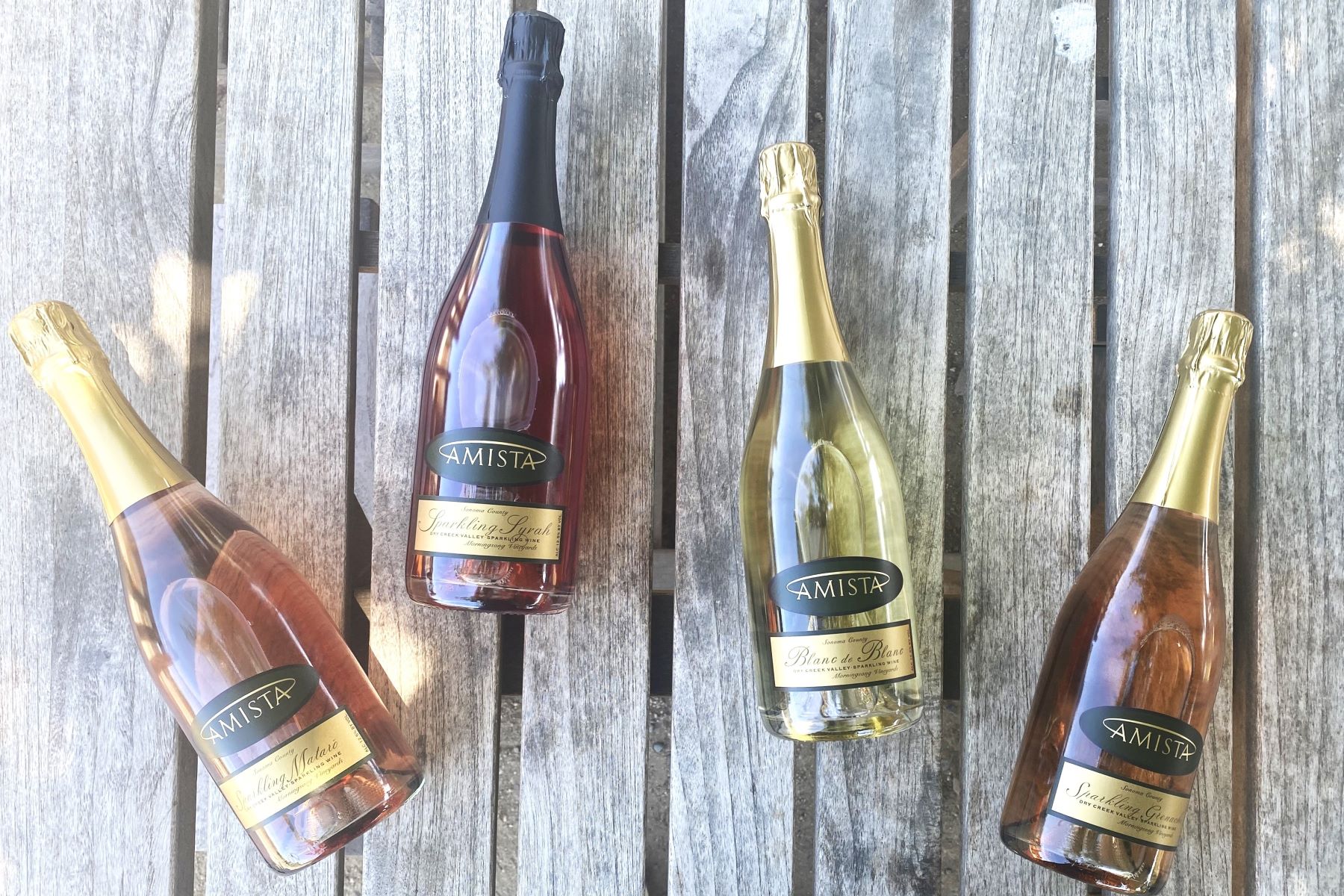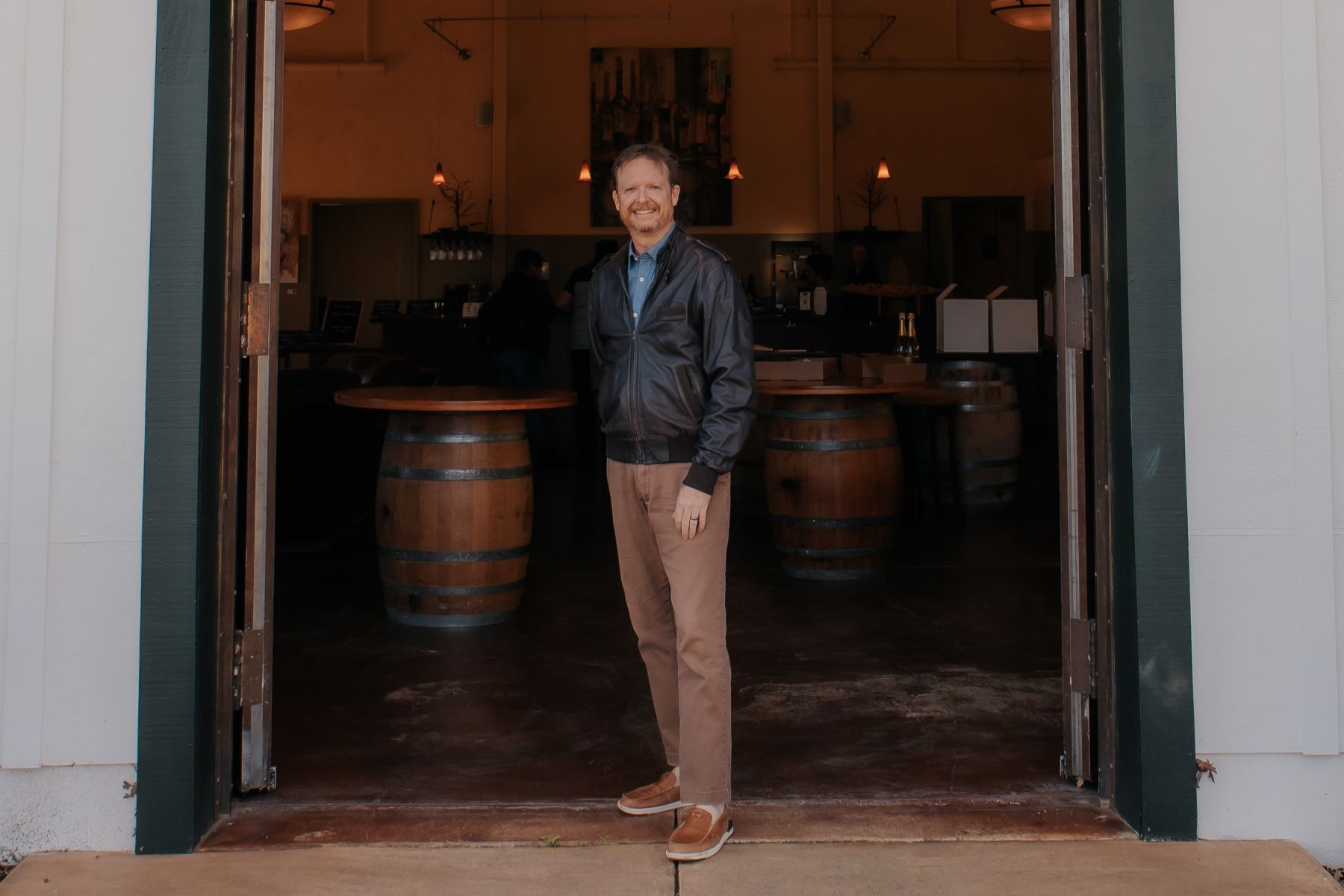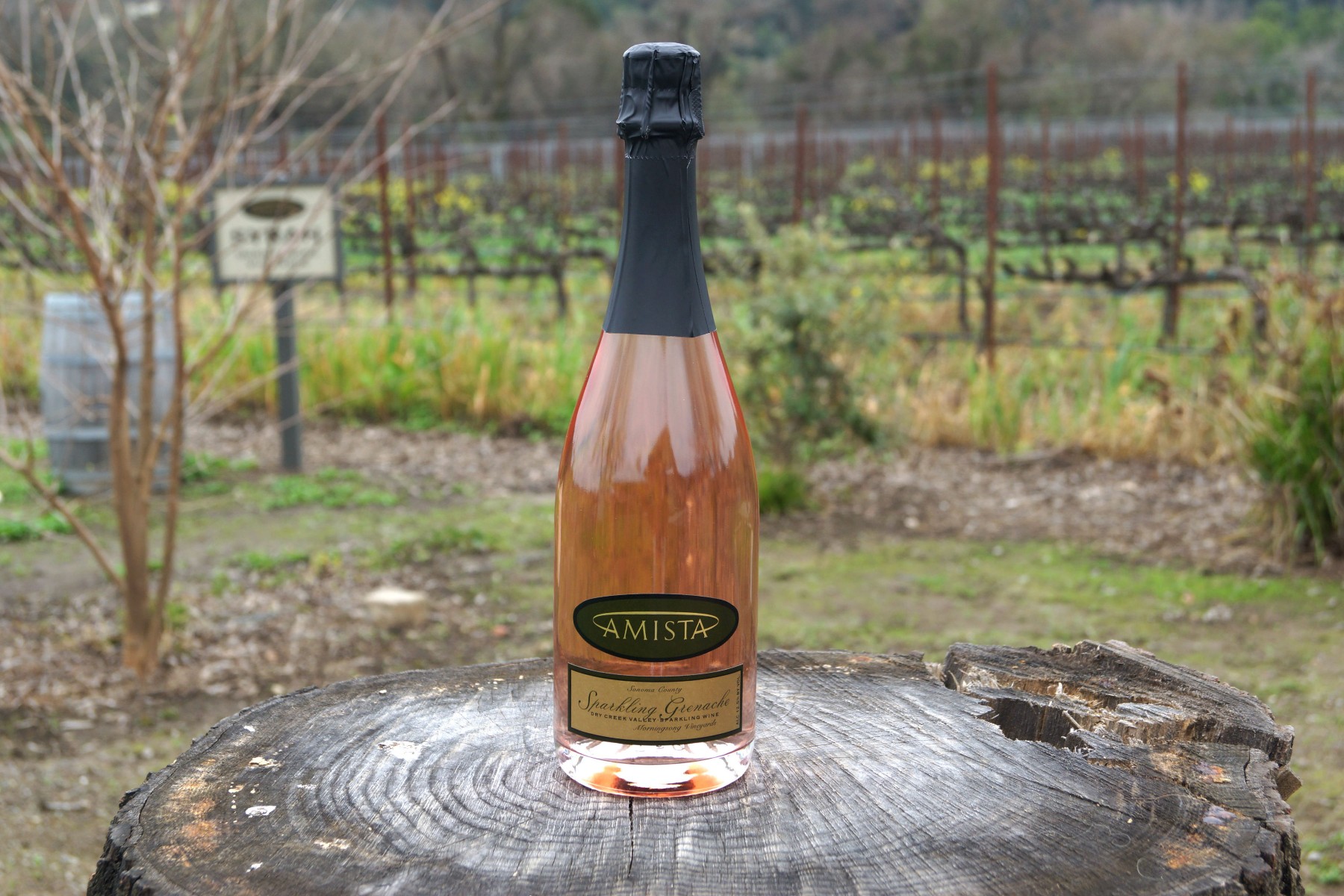Amista Vineyards - Sonoma Sparkling Wineries - Discover 10 Of The Best

We are thrilled to learn that Amista has been recognized as one of the top sparkling wineries in Sonoma wine country by Grape and Barrel. When asked to recommend a tour of the best sparkling wineries in Sonoma for a group of friends, Grape and Barrel eagerly shared their top ten picks, saying, “…we want to personally introduce our readers to the incredible creators who strive to make the best sparkling wine in Sonoma County.”
In addition to the Top Ten list, the article delves into the fascinating history of Champagne, debunking the myth that it was invented by the monk Dom Perignon. It also explains the unique method used to make Champagne and sparkling wines, highlighting the key difference from still wines: sparkling wines undergo a second fermentation process, which creates their signature bubbles.
Amista: One of the Top 10 Sparkling Wineries in Sonoma
We are truly honored to be included among this all-star cast of sparkling wineries. The description states, “Amista’s owners had their minds set on producing sparkling wine when they acquired the winery…” To be completely honest, we didn't even consider making sparkling wine until several years later. Our first releases were Chardonnay, Syrah, Zinfandel, and Cabernet.
Amista’s First Sparkling Wine: Sparkling Syrah
The idea of making sparkling wine first occurred to us in 2007, thanks to a class project by our then consulting winemaker. We are forever grateful for his initiative, as he and his class created a Sparkling Syrah using the Methode Traditionnelle (also known as Methode Champenoise). When we tasted it, it was love at first sip. Inspired by this success, we produced our first Sparkling Syrah for Amista in 2008.
A Collection of Unique Sparkling Wines at Amista
Over the years, with the enthusiastic encouragement of our current winemaker, Ashley Herzberg—who loves bubbles—we have expanded our collection to seven unique sparkling wines. While traditional Champagnes and many sparkling wines worldwide are made from a few classic varieties (only six grape varieties are permitted in Champagne, with most wines made from Chardonnay, Pinot Noir, and Pinot Meunier), we have become trailblazers by crafting sparkling wines from mostly non-traditional grapes, just as we did with our Sparkling Syrah.
We honor tradition with our Blanc de Blanc and Amistara, both made from Chardonnay. However, our other sparkling wines, crafted using the traditional Champagne method, are made from Rhône varieties or unique blends. This showcases our innovative spirit and commitment to creating distinctive wines.
What is Estate Grown?
The grapes for all our sparkling wines are grown right here on our estate, Morningsong Vineyards. Here's an insider tip: the names of the wineries that produce the wine and the names of the vineyards where the grapes are grown are often different, even when the estate belongs to the winery, as in our case. This can be confusing. Wines can be referred to as vineyard designate wines, meaning that 95% of the grapes must come from the particular vineyard listed on the label. It’s similar to how a department store like Bergdorf Goodman sells brands identified by the supplier’s name, such as Prada or Ferragamo.
For example, our Amista Vineyards Zinfandel is a vineyard designate from a neighboring vineyard, Saini Farms, while our Sparkling Syrah is a vineyard designate from our own estate, Morningsong Vineyards.
Amista Sparkling Syrah – A Daring Move
Grape and Barrel highlights, “…they launched their sparkling Syrah – a pretty daring move in Sonoma but a longstanding practice in Australia, where Syrah grapes are made into sparkling Shiraz." Truth be told, it didn’t feel daring, although we knew it was unique. We had never tasted a sparkling Syrah until our consulting winemaker's class created one. Before that, we had been producing a rosé of Syrah, also the result of a happy accident, which served as the base for the class’s sparkling wine.
In Australia, Sparkling Shiraz is quite different. Unlike our Sparkling Syrah, which is technically a rosé, Sparkling Shiraz is a sparkling red wine, much deeper in color. Despite the difference in name, Shiraz is simply another term for Syrah, and both wines are made from the same grape variety.
Plus an All-Sparkling Amista Wine Club
“The Farrows were so obsessed with sparkling wine that they founded the Amista Sparkling Friends wine club in 2014,” the article continues. By then, we had enough sparkling wines—our collection of sparkling "gems"—to create a sparkling-only wine club. As lovers of bubbles, we knew other enthusiasts would want the same option. While we already had a wine club for our red and white wines, we launched “Sparkling Friends” at Passport to Dry Creek Valley, the premier wine and food event in the area, showcasing our Blanc de Blanc with freshly shucked oysters!
We want our sparkling-loving club members to have first “pop” at our limited production, estate-grown sparkling wines. We are a small “grower sparkling house,” much like the small grower Champagne houses in France. Our production is extremely limited, and our sparkling wines often sell out before the next release.
We like to joke that we make sparkling wines for ourselves and love to share! That’s what friends do—share their discoveries with their friends! Amista means making friends, so it just makes sense.
See the whole list in Sonoma Sparkling Wineries Discover 10 Of The Best in Grape and Barrel
Still Thirsty?
If you want to learn more, here is a curated list of resources.
What is Sparkling Wine: Sparkling Wine Defined
Traditional Method for Making Champagne & Sparkling Wines: Méthode Champenoise
Sparkling Shiraz: Sparkling reds & why you should be drinking them!
Spotlight on Amista Vineyards Brian Shapiro and The Wine Business Institute

We’re thrilled to share that Amista Estate Director, Brian Shapiro, was recently featured in an article about the Wine Business Institute at Sonoma State University. A 2010 graduate of the program, Brian reflected on his experience, saying, “I knew I wanted to study at the Institute and appreciated the interconnection between business and academia.” His unique blend of practical experience and academic knowledge, along with the strong network he built during his time at the Institute, has been invaluable to our team. “I valued the opportunities to work and learn with people in the industry,” he added. This connection between academic coursework and industry professionals is a hallmark of the Wine Business Institute, where many courses are taught by seasoned industry veterans.
What is the Wine Business Institute?
Founded in 1996, the Wine Business Institute was established in collaboration with Sonoma State University’s School of Business to address the business aspects of the wine industry. Sonoma State was the first university in the United States to offer an undergraduate degree (since 1998), an MBA (since 2008), and an Executive MBA (since 2012) specifically in wine business. While many programs focus on viticulture and winemaking, the Wine Business Institute stands out for its unique emphasis on the business side of the wine industry. Even today, it remains the only program of its kind in the U.S. and one of only three worldwide.
Gary Heck, Owner and President of Korbel Winery, was an early supporter and continues to serve as Chairman of the Board. The board includes leaders from various sectors of the wine business, from small to large wineries, online retailers, distribution companies, corporate finance and accounting, winery M&A, and wine associations.
Amista Proprietor Vicky Farrow’s Longstanding Connection to Wine Business Institute
Amista’s own Vicky Farrow has a rich history with the Institute, having served on its Board of Directors since 2022. Her involvement began in 2011 when she met Executive Director Ray Johnson and was inspired by his innovative work. Vicky’s enthusiasm led her to volunteer in expanding the board and facilitating strategic planning sessions. Over the years, she has witnessed the Institute’s growing impact and the rise of its graduates as the next generation of wine business leaders.
Amista Celebrates Our Wine Business Institute Graduates
At Amista, we take great pride in our team members who are graduates of the Wine Business Institute. One standout is a team member working in hospitality and sales in our tasting room. He took a brief leave to gain hands-on experience as a harvest intern at Kosta Browne Winery and returned to manage our local wholesale program. Starting as an intern during his senior year, he has continually grown in expertise and confidence.
We have welcomed several Sonoma State graduates over the years, each bringing fresh ideas and energy. We are dedicated to supporting their development, offering hands-on experience and opportunities for growth. While we know many will move on to bigger roles, we take pride in watching their careers blossom and knowing we played a part in their journey.
Amista Salutes the Wine Business Institute's Track Record of Success
In 2016, the Institute broke ground on the Wine Spectator Learning Center, a dedicated facility on the Sonoma State University campus, funded in part by a three-million-dollar gift from the Wine Spectator Scholarship Foundation. Marvin Shanken, editor and publisher of Wine Spectator, along with California Governor Gavin Newsom and Representative Mike Thompson, attended the groundbreaking ceremony.
Bill Silver, then Dean of the School of Business, remarked, “Success in the wine business depends on human capital. In the future, we will see the children of winemakers and vineyard workers coming through those doors." His words were prophetic, as today, dozens of children of vineyard and winery workers have graduated from Sonoma State thanks to the Wine Industry Scholars Program (WISP) launched in 2017. These graduates, with determination, family support, and financial assistance from WISP, have become the first in their families to earn a college degree.
Arguably, the most notable accomplishment of the Institute is the number of graduates who represent the next generation of leaders in the wine business. They are making their marks in renowned wineries and distributors such as Silver Oak, J Vineyards, Rombauer, Korbel, Tablas Creek, Duckhorn, Jackson Family, Gary Farrell Winery, Young’s Market, and Constellation Brands, to name a few. At Amista, we are committed to the growth and development of everyone on our team and look forward to welcoming future WBI graduates.
Learn more about the Institute and its graduates in From Root to Shoot, SSU's Wine Business Institute Grows Success Stories.
Amista Featured in Vineyard Specific Sonoma County Bubbles for New Years

Amista Sparkling Grenache
Virginie Boone, a noted journalist who writes about Napa and Sonoma wines for publications like Wine Enthusiast, the New York Times and Food and Wine, featured a wonderful list of vineyard specific bubbles for the holidays. We are honored that our Amista Sparkling Grenache was among the wines she recommended. Boone describes it as, “Made in a Brut Nature style from estate vineyards, this is a bright, fruit-forward and fun bottling that remains balanced in the glass.”
Exploring Vineyard Designate Sparkling Wines
It is refreshing to see a list of vineyard specific sparkling wines. Virginie writes a weekly series called “The Good Stuff” for the Sonoma County Winegrowers, so it is fitting to celebrate the vineyards where the grapes are grown. Boone encourages people to explore sparkling wines from Sonoma County saying, “Take that exploration up a notch by choosing a vineyard-designated sparkling wine, which’ll highlight who farmed the grapes and where.”
Check out her recommendations at Vineyard-specific Sonoma County Bubbles for New Year’s on the Good Stuff blog by Virginie Boone.
Non-traditional Grapes Varieties for Sparkling Wines
Our Sparkling Grenache is the only wine on the list not made from Chardonnay or Pinot Noir grapes. Those two varieties are the traditional grapes used most often in Champagne and in many sparkling wines around the world.
At Amista, we love to create non-traditional sparkling wines using the Rhône varieties grown on our estate, including Syrah, Grenache, Mourvèdre and blends of the three. We also honor tradition with our Amista Blanc de Blanc, made from 100% Chardonnay grapes, which we’ve made every year since 2011.
The Debut of Amistara, a Sparkling Blanc de Blanc to Celebrate 20 Years
In 2024 we will debut a second Blanc de Blanc called Amistara to celebrate Amista’s 20th anniversary. Amistara is a vineyard designated wine from our own estate, Morningsong Vineyards. It is even more special because it comes from one small block of Chardonnay growing on the famous Wente clone root stock.